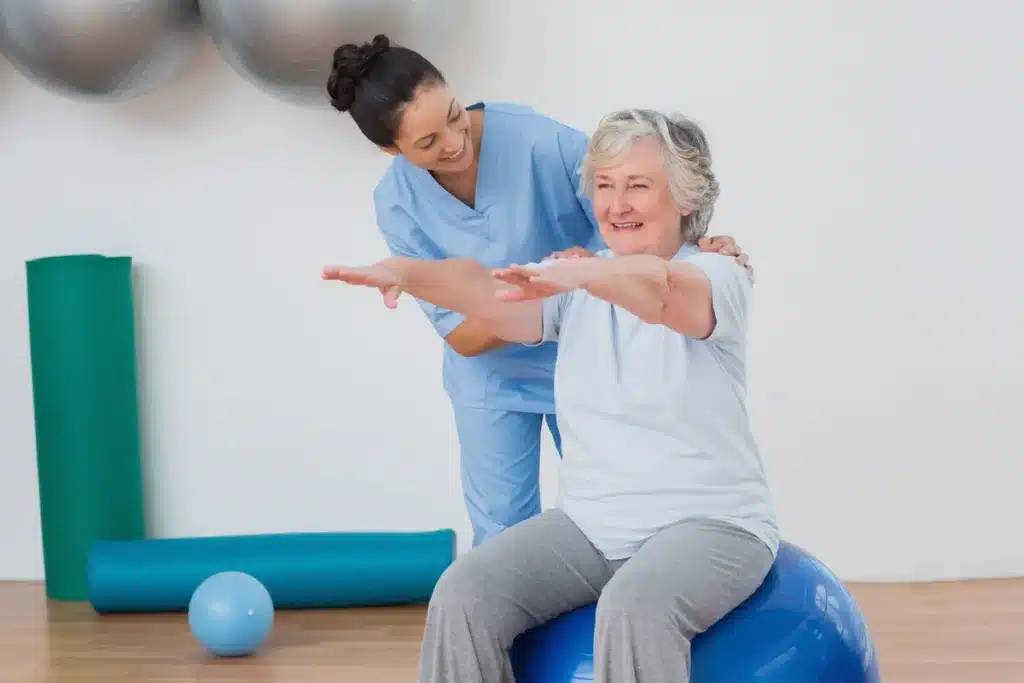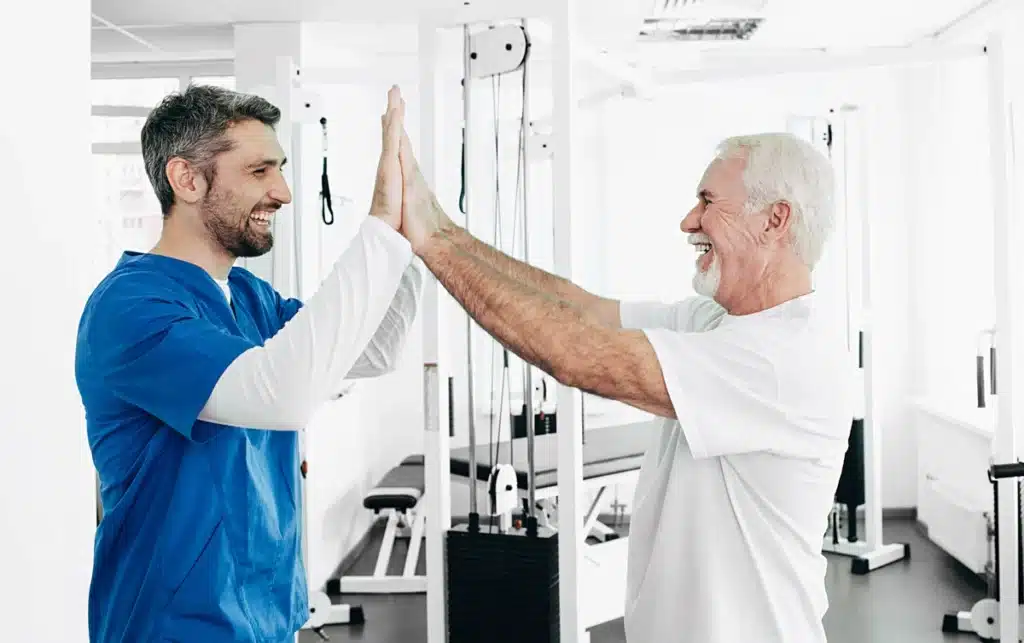Every 40 seconds, someone in the United States suffers a stroke, making it one of the most prevalent neurological disorders. Surviving a stroke is often the beginning of a challenging journey, marked by physical, emotional, and cognitive obstacles.
However, amidst this turmoil, there exists a beacon of hope: physical therapy. In this comprehensive guide, we delve into the realm of physical therapy after stroke, exploring:
- Its importance
- Methods of physical therapy
- The path to recovery
What Is A Stroke?
Before delving into the nuances of physical therapy, it’s crucial to understand what a stroke is. A stroke occurs when blood flow to the brain is interrupted, either by a blockage (ischemic stroke) or bleeding (hemorrhagic stroke). As a result, brain cells are deprived of oxygen and begin to die rapidly. The consequences of a stroke vary depending on the affected area of the brain and the extent of the damage.
Common Signs of a Stroke
Recognizing the signs of a stroke is paramount for prompt medical intervention, as every minute counts. Common symptoms include:
- Sudden numbness or weakness in the face, arm, or leg, especially on one side of the body
- Confusion
- Trouble speaking or understanding speech
- Sudden trouble seeing in one or both eyes
- Difficulty walking
- Dizziness
- Severe headache with no known cause
Remembering the acronym FAST (Face drooping, Arm weakness, Speech difficulty, Time to call emergency services) can aid in swift identification and action.
Consequences of a Stroke
The aftermath of a stroke can be profound and multifaceted. Physical impairments such as paralysis, muscle weakness, and coordination difficulties often manifest, hindering mobility and independence. Additionally, stroke survivors may grapple with cognitive challenges, including:
- Memory loss
- Difficulty with problem-solving
- Emotional disturbances like depression and anxiety
These consequences underscore the necessity of comprehensive rehabilitation, with physical therapy playing a central role.
The Importance of Physical Therapy: 5 Factors
Physical therapy is a cornerstone of stroke rehabilitation, aiming to optimize function, enhance mobility, and improve quality of life. The importance of physical therapy after a stroke cannot be overstated, and here are some key reasons why:
1) Restoring Mobility:
Physical therapy addresses the physical impairments that often accompany stroke, such as muscle weakness, spasticity, and balance deficits. Through targeted exercises and interventions, physical therapists work to restore mobility and functional independence, enabling stroke survivors to perform activities of daily living with greater ease and confidence.
2) Preventing Complications:
Prolonged immobility and muscle weakness post-stroke can predispose individuals to secondary complications such as pressure ulcers, deep vein thrombosis, and contractures. Physical therapy interventions, including range of motion exercises, positioning techniques, and mobility training, help mitigate these risks and promote overall health and well-being.
3) Facilitating Neuroplasticity:
Neuroplasticity refers to the brain’s ability to reorganize and form new neural connections in response to injury or learning. Physical therapy interventions, such as task-specific training and constraint-induced movement therapy, harness the principles of neuroplasticity to promote motor recovery and functional gains post-stroke.
4) Improving Quality of Life:
Stroke survivors often experience significant reductions in quality of life due to physical limitations, pain, and functional impairments. Physical therapy interventions not only address these challenges but also empower individuals to participate more fully in meaningful activities and social interactions, enhancing overall quality of life.
5) Maximizing Independence:
Independence is a primary goal of stroke rehabilitation, allowing individuals to live life on their own terms and maintain a sense of autonomy and dignity. Physical therapy plays a crucial role in maximizing independence by optimizing physical function, mobility, and self-care skills.
Types of Physical Therapy for Stroke Rehabilitation
When it comes to recovery from a stroke, there isn’t a one size fits all option. Here are some different types of physical therapy that may help you in your journey.
- Mobility Training: Mobility impairments are a hallmark of stroke, often necessitating intensive rehabilitation. Physical therapists employ various techniques to enhance mobility, including gait training, balance exercises, and transfers from bed to wheelchair and vice versa. These interventions not only promote physical function but also boost confidence and autonomy.
- Strength and Endurance Exercises: Muscle weakness is a common sequelae of stroke, significantly impacting functional abilities. Physical therapists design strength and endurance training programs tailored to individual needs, utilizing resistance bands, weights, and functional activities to improve muscle tone and stamina.
- Range of Motion Exercises: Contractures and stiffness frequently arise post-stroke, limiting joint mobility and exacerbating functional deficits. Range of motion exercises, coupled with manual therapy techniques such as stretching and joint mobilization, aim to alleviate these issues, restoring flexibility and optimizing movement patterns.
- Constraint-Induced Movement Therapy (CIMT): CIMT is a specialized approach that involves constraining the unaffected limb while intensively training the affected limb. By fostering neuroplasticity and encouraging the use of the impaired limb, CIMT facilitates motor recovery and functional gains.
- Task-Specific Training: Task-specific training focuses on practicing activities relevant to daily life, such as dressing, cooking, and grooming. Through repetitive practice and skill refinement, stroke survivors can regain independence in essential activities, enhancing their overall quality of life.
Finding a Good Physical Therapist
Choosing the right physical therapist is pivotal in achieving optimal outcomes post-stroke. Consider the following factors when seeking a qualified professional:
✅ Credentials:
Ensure that the physical therapist is licensed and certified by reputable organizations such as the American Physical Therapy Association (APTA).
✅ Experience:
Look for therapists with expertise in stroke rehabilitation and a track record of success in improving functional outcomes.
✅Communication:
Effective communication is essential for a productive therapist-patient relationship. Seek a therapist who listens attentively, explains treatment plans clearly, and addresses concerns promptly.
✅ Collaboration:
A collaborative approach involving the patient, therapist, and other healthcare professionals fosters holistic care and facilitates progress.
✅ Personalized Care:
Opt for a therapist who tailors treatment plans to individual needs, goals, and preferences, ensuring personalized care and maximum effectiveness.
Other Ways to Support Your Recovery
In addition to physical therapy, several other strategies can augment stroke recovery:
- Occupational Therapy: Occupational therapy focuses on regaining independence in activities of daily living, such as bathing, dressing, and meal preparation. Collaborating with an occupational therapist can enhance functional abilities and promote autonomy.
- Speech Therapy: Speech therapy addresses communication difficulties, swallowing impairments, and cognitive deficits often associated with stroke. By targeting these areas, speech therapists facilitate improved speech, language, and swallowing function.
- Psychological Support: Coping with the emotional aftermath of a stroke can be daunting. Seeking support from mental health professionals, support groups, or counseling services can alleviate distress and promote psychological well-being.
- Healthy Lifestyle Choices: Adopting a healthy lifestyle is paramount for stroke prevention and recovery. Encourage regular exercise, balanced nutrition, adequate sleep, and stress management techniques to optimize physical and mental health.
Supporting Stroke Patients
Stroke rehabilitation is a multifaceted journey characterized by resilience, determination, and hope. Through the guidance of skilled physical therapists and a comprehensive rehabilitation approach, stroke survivors can reclaim mobility, independence, and quality of life. By understanding the significance of physical therapy, exploring various interventions, and embracing a holistic approach to recovery, individuals can navigate the challenges of stroke with courage and perseverance.
Remember, the road to recovery may be arduous, but with perseverance and support, every step forward is a triumph. And Sunflower Communities is here to support your loved one through every step of the journey. Contact us today to learn more!



